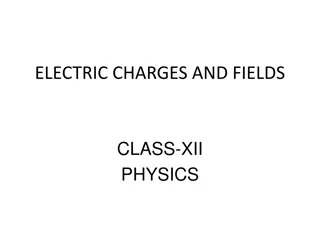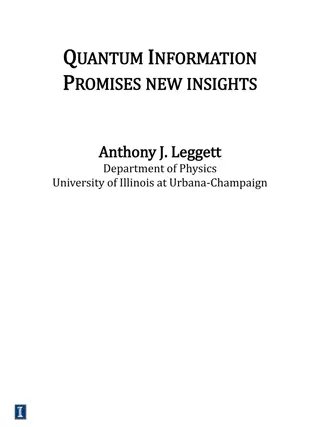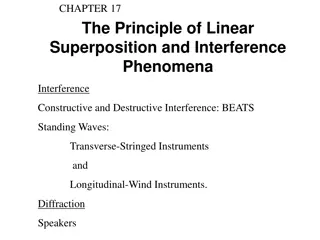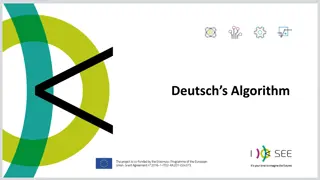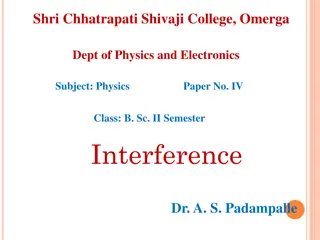Exploring Wave Interference in Physics: Superposition, Constructive, and Destructive Interference
Delve into the fascinating world of wave interference in physics, from understanding the concept of superposition to identifying constructive and destructive interference patterns. Discover how light waves interact through different paths and sources to create coherent or incoherent light. Explore t
3 views • 37 slides
Electric Charges and Fields in Physics
Electrostatics is the study of forces, fields, and potentials arising from static charges, including positive and negative charges which interact based on the principles of like charges repelling and unlike charges attracting. By convention, electrons are considered negative, while protons are posit
1 views • 12 slides
Color Superposition in Everyday Life
Dive into a fascinating exploration of color superposition in everyday life through the lens of primary colors and their combinations. Learn how our understanding of colors can vary based on our perception and knowledge, leading to intriguing insights about the nature of color itself.
0 views • 27 slides
Superposition Theorem in Electrical Circuits
Superposition theorem in electrical circuits states that the effects of multiple voltage and current sources in a network can be analyzed independently and then combined algebraically. This allows for calculating the voltage and current distribution in a network more efficiently. The theorem involve
0 views • 9 slides
Digital Signal Processing (DSP) Systems: Linearity, Causality, and Stability
Digital Signal Processing (DSP) involves converting signals between digital and analog forms for processing. The general block diagram of a DSP system includes components like D/A converters, smoothing filters, analog-to-digital converters, and quantizers. DSP systems can be classified based on line
1 views • 12 slides
Interference and Beats in Waves
Explore the fascinating phenomena of interference and beats in waves, where overlapping waves interact to create patterns of constructive and destructive interference. Witness how sound waves can also produce beats when interfering in time, resulting in a slow envelope effect. Delve into the princip
1 views • 40 slides
Gravity and Magnetic Models in Geophysics
Construction of gravity and magnetic models involves principles of superposition to isolate anomalies, reference ellipsoids, geoid, and various corrections like drift, latitude, free air, Bouguer, and terrain corrections. Gravity anomalies are determined by subtracting multiple factors from observed
0 views • 15 slides
Electric Potential in Physics
Today's lecture covers the concept of electric potential, superposition principle, representation with equipotential lines, relation with electric field, and applications like Electrocardiogram (ECG). It explains the definition of electric potential, its scalar nature, and calculation examples invol
0 views • 22 slides
Quantum Information through Polarization of Photons
Quantum information and photon polarization are explored in this detailed presentation featuring the ultimate quantum 2-state system. The content delves into the behavior of single photons at a quantum level, showcasing the intriguing properties and implications of quantum superposition in polarizat
1 views • 14 slides
Superconductors: A Comprehensive Study
This content delves into the world of superconductors, focusing on the properties of NbTi, magnetic field superposition, Meissner effect, thermodynamics, and experimental procedures. It covers various aspects such as quantitative cooling, control of magnetic fields, and the interaction between super
0 views • 16 slides
Interference Phenomena and Standing Waves in Musical Instruments
Explore the principle of linear superposition, constructive and destructive interference, beats, and standing waves in transverse and longitudinal instruments. Discover the complexity of sound waves and how spectrum analyzers analyze harmonic frequencies. Calculate the fundamental frequency in a hum
1 views • 7 slides
Unraveling the Geologic Mysteries of Earth's History through Dating Methods
Delve into the fascinating world of Earth's history and dating techniques with images and puzzles exploring concepts like relative dating using the Law of Superposition, geological layer sequencing, and absolute dating through half-life principles. Learn how scientists decipher the age of the Earth
0 views • 10 slides
Gravity and its Applications
Explore the fascinating world of gravity through topics like the law of gravity, gravitational force, superposition, and more. Dive into concepts such as net gravitational force, acceleration due to gravity, and gravitational forces in various scenarios. Understand how gravity influences objects in
1 views • 68 slides
Deutsch's Algorithm in Quantum Computing
Deutsch's Algorithm is a fundamental quantum algorithm designed to solve the problem of determining if a given function is constant or balanced. This algorithm leverages quantum principles such as superposition and entanglement to provide a more efficient solution compared to classical methods. By e
0 views • 17 slides
Electric Charges and Fields in Physics
Explore topics such as superposition of forces, electric fields, particle interactions, potential differences, and cathode-ray tube concepts in physics involving charges, forces, and fields. Understand scenarios like calculating total electric force between charges, finding electric fields at specif
1 views • 10 slides
Wave Properties and Standing Waves in Physics
Exploring the concepts of periodic waves, superposition, and standing waves in physics using examples such as a Slinky, two waves traveling in opposite directions, and a guitar string. Learn about wave speed, frequency, wavelength, nodes, antinodes, and the impact of tension on wave propagation. Dis
2 views • 17 slides
Two-Source Interference Patterns
Dive into the fascinating world of two-source interference patterns with the superposition principle, constructive and destructive interference concepts, and demonstrations illustrating how overlapping waves interact. Explore scenarios like people talking simultaneously and ripples on a pond to gras
0 views • 31 slides
Groundwater Hydraulics: Well Pumping and Superposition Analysis
This content delves into various aspects of well pumping in groundwater hydraulics. It covers topics such as boundaries, superposition, confined and unconfined aquifers, pumping near streams, and practical examples. The visuals aid in understanding concepts like drawdown at wells and the effects of
0 views • 30 slides
Rock Ages: A Geologic Perspective
Geologists determine the ages of rocks and the Earth using principles like Uniformitarianism, Relative Age, Law of Superposition, and Principle of Original Horizontality. By analyzing rock layers, sedimentary structures, and unconformities, they estimate Earth's age to be around 4.6 billion years ol
0 views • 15 slides
Modern Subjectivity through Migrant Women
This research delves into the intricate nexus of migrant women's experiences within the global landscape, examining how their presence shapes and challenges conventional notions of identity. Through concepts like superposition and ectopic subjectivity, the study elucidates the multi-faceted nature o
0 views • 8 slides
More Electric Fields
Today's lecture covers continuous charge distributions, visualization of electric fields, superposition principle, field from equal charges, uniform line of charge, and plane of charge in physics. Explore concepts with diagrams and explanations.
0 views • 19 slides
Introduction to SOMA
This document introduces the concept of Superposition Transmission and Non-Orthogonal Multiple Access (NOMA) in wireless communication systems. It covers topics such as Radio Multiple Access techniques, MultiUser Superposition Transmission (MUST), and NOMA with adaptive power ratios. The content als
0 views • 12 slides
DIFFRACTION AND INTERFERENCE
Delve into the phenomena of wave interference, diffraction, and the formation of stationary waves. Discover the principles of superposition and the creation of interference fringes using laser sources. Unveil the intriguing concept of path difference and coherence, along with the applications in spe
0 views • 40 slides
Interference
Delve into the fascinating world of interference patterns created by waves and discover the mathematical description of waves with localized characteristics in the wave-particle duality concept. Uncover the implications of the Uncertainty Principle on wave packets and Gaussian wavepackets. Explore t
0 views • 7 slides
Unraveling Geological Mysteries with the Law of Superposition
In the world of geology, the Law of Superposition plays a crucial role in deciphering the Earth's history. This law helps determine the relative ages of different geological layers by examining their sequence of formation. By understanding how sedimentary rocks are deposited over time, we gain insig
0 views • 16 slides
PROJECTILE MOTION
Fundamental concepts of projectile motion, where objects follow paths influenced by gravity and initial velocity. Dive into the separable X and Y motion components, superposition principle, initial velocity considerations, equations for motion, and trajectories on level ground. Discover the interpla
0 views • 8 slides
Electric Potential and Superposition Principles
Learn about electric potential, superposition principle, equipotential lines, and their relation with electric field. Understand the scalar nature of electric potential, its calculation due to charges, and the concept of total potential in systems with multiple charges. Dive into practical applicati
0 views • 22 slides
Understanding Electric Fields and Superposition Principle in Physics 102 Lecture 3
Learn about the electric field, superposition principle, and how to represent electric fields using field lines. Explore concepts like dipoles, conductors, and calculations for electric fields. Dive into scenarios involving point charges, lines of charges, and planes of charges. Test your understand
0 views • 22 slides
Understanding Interference in Physics: Superposition and Types
Explore the principles of superposition and different types of interference in physics, such as constructive and destructive interference. Learn about the conditions required for steady interference of light and interference in thin films due to reflected light.
0 views • 22 slides
Wave Interference and Applications in Light Waves
Explore the concepts of superposition principle, interference, constructive and destructive interference, their visual representations, and applications in light waves. Learn how interfering light waves create colors in soap bubbles due to constructive and destructive interference. Discover the fasc
0 views • 20 slides
Understanding Light Waves: Interference, Diffraction, and Polarization Explained
Discover the fundamental features of light waves, including interference, diffraction, and polarization. Explore the concept of waves in daily life and how disturbances in a medium lead to wave propagation. Learn about wave interactions and superposition, as well as the intriguing phenomena of inter
0 views • 19 slides
Understanding Wave Behavior in Physics
Explore the characteristics of waves, including mechanical, electromagnetic, and matter waves. Learn about wavefronts, superposition, and the different classes of waves. Discover how electromagnetic radiation differs from other types of waves and the concept of phase angles in wave behavior.
0 views • 12 slides
Quantum Computation and the Church-Turing Thesis
Explore the realm of quantum computation, its potential to revolutionize computing, and the fundamental concept of the Church-Turing Thesis. Delve into the principles of quantum superposition, qubit implementations, and the unique capabilities of quantum computers in this insightful content.
0 views • 37 slides
Power System Analysis and Linear/Nonlinear Elements Overview
Learn about power flow analysis, linear vs. nonlinear systems, linear and nonlinear power system elements, and the challenges of solving nonlinear problems in power systems. Understand how linear elements can be analyzed using superposition, while nonlinear elements require iterative approaches. Exp
0 views • 32 slides
Understanding Electric Field in Conductors and Dielectrics
Learn about the behavior of electric fields inside conductors and dielectrics in static situations, including the distribution of charge on a charged conductor's outer surface and the polarization of nonpolar and polar dielectrics. Explore the concept of relative permittivity and the superposition o
0 views • 4 slides
Understanding Convolution of Discrete-Time Signals in Pattern Recognition and Signals
Learn about the representation of DT signals, response of DT LTI systems, convolution examples, and properties in the context of pattern recognition and signals processing. Topics include exploiting superposition, time-invariance, unit pulses, LTI systems, impulse response, and visualization of conv
0 views • 14 slides
Electromagnetic Waves and Antenna Sources: Lectures on Superposition and Scattered Radiation
Explore the concepts of superposition and scattered radiation in electromagnetic waves, along with discussions on scalar and vector potentials, antenna sources, and vector potential generation. Delve into the intricate details of electromagnetic wave behavior from time-harmonic sources and the impli
1 views • 20 slides
Understanding Superposition Principle in Mechanics of Materials
Explore the Superposition Principle in Mechanics of Materials, a technique to solve complex problems by breaking them into simpler ones. Learn how to apply this principle to analyze beam deflection and loading scenarios with examples provided.
0 views • 7 slides
Understanding Superposition Theorem in Electrical Engineering
Explore the Superposition Theorem in electrical engineering, which states that in a network with linear resistances and multiple sources of e.m.f., the current in any branch is the algebraic sum of currents resulting from analyzing each source separately. Dive into examples and applications in Mecha
0 views • 7 slides
Advanced Analysis Techniques for Circuits in EMLAB
Explore additional analysis techniques like superposition, Thevenin's and Norton's theorems, maximum power transfer, and application examples in EMLAB. Learn about linearity in systems, equivalent circuits, and how to use superposition to simplify linear circuits. Dive into examples showcasing the a
0 views • 27 slides

